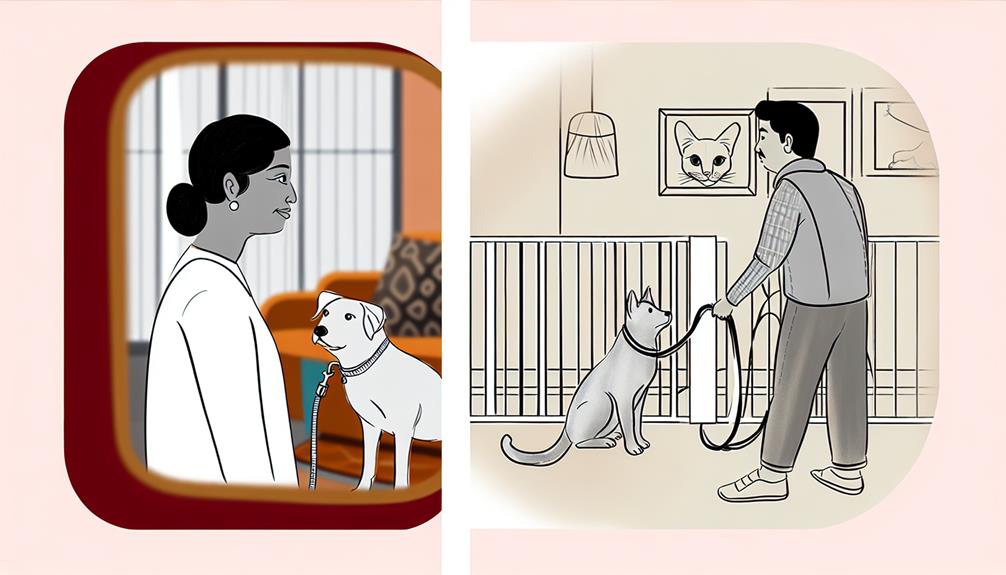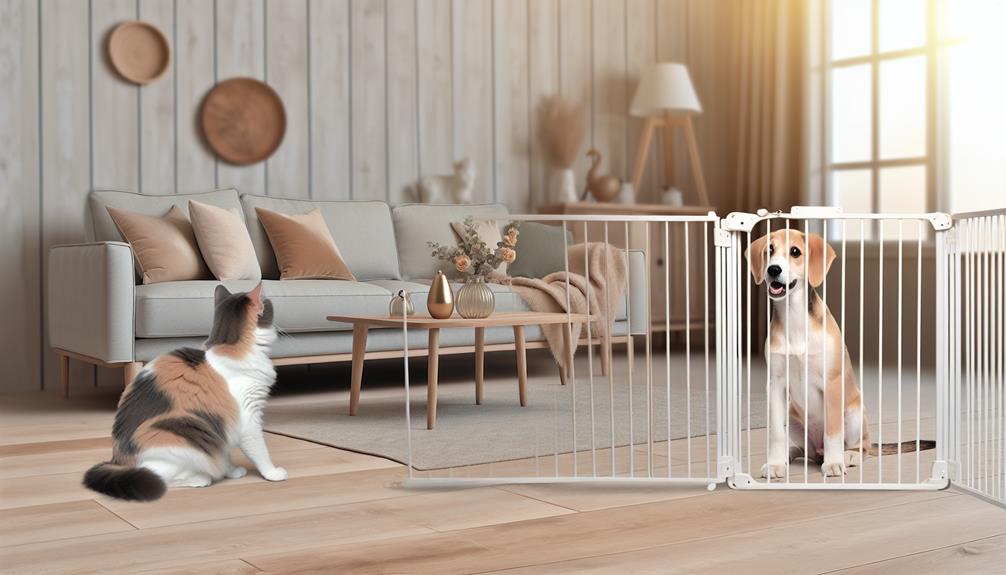Introducing a cat to a dog can be a delicate process, but with the right approach, it's entirely manageable. You'll want to start by creating separate spaces for each pet, allowing them to acclimate to each other's scents without direct contact. This initial phase is vital for setting a positive tone. Controlled interactions using barriers like baby gates can then help ease their first face-to-face meetings. But how can you guarantee these introductions go smoothly and what signs should you look for to gauge their comfort levels? There's more to explore in the steps that follow.
Preparation and Planning
When it comes to introducing a cat to a dog, preparation and planning are essential to ensuring a smooth changeover for both animals. The first step is to focus on the environment setup. You'll want to designate separate areas for each pet initially. This helps them feel secure and reduces the likelihood of territorial disputes. Make sure each area is equipped with essentials like food, water, bedding, and litter boxes for the cat. A secure, elevated space for the cat can also provide a sense of safety, allowing them to observe the dog from a distance.
Next, consider the scent introduction. Animals rely heavily on their sense of smell to understand their surroundings and other creatures. Start by swapping bedding or toys between the cat and dog. This helps them get used to each other's scent without direct contact. You might also rub a soft cloth on one animal and place it near the other's space. This gradual exposure can ease the initial shock and create a sense of familiarity.
Additionally, it's beneficial to establish routines. Consistent feeding times, play sessions, and quiet moments can create a predictable environment. This stability can reduce stress for both pets. Don't forget to monitor their body language closely during this period. Signs of stress or aggression should be addressed promptly.
First Impressions
After establishing a well-prepared environment and familiarizing your pets with each other's scents, it's time to focus on their first face-to-face meeting. This initial interaction is critical and sets the tone for their future relationship. Start by observing their body language closely. Both animals should be calm and relaxed; any signs of aggression or fear, such as growling, hissing, or raised fur, indicate that they're not ready for direct contact yet.
Set the stage by choosing a neutral space where neither animal feels territorial. Make certain this area is free from distractions and has escape routes, such as high perches for the cat and open spaces for the dog. Before the meeting, engage in a brief scent exchange by rubbing a cloth on each pet and placing it near the other. This helps them recognize and feel more comfortable with the new scent.
When introducing them, have your dog on a leash for better control. Allow the cat to approach at its own pace. Watch for positive body language like relaxed ears, slow blinks from the cat, and a wagging tail or relaxed posture from the dog. These signs indicate curiosity rather than aggression.
Be patient and calm, as your demeanor will influence your pets. Talk in soothing tones and offer treats to both animals to create positive associations. If either pet shows signs of stress or aggression, calmly separate them and try again later. Remember, this first impression is foundational, so prioritize a calm and controlled environment to foster a positive initial interaction.
Controlled Interactions

Easing into controlled interactions is essential for a smooth change in your pets' relationship. This phase requires careful planning and patience, as it sets the foundation for positive encounters between your cat and dog.
Begin with scent swapping to allow them to become familiar with each other's presence without direct contact. Place items that carry each pet's scent, such as bedding or toys, in the other's space. This indirect introduction can reduce anxiety and build curiosity. Scientific studies suggest that scent swapping helps animals recognize and accept each other as part of their environment.
Once both pets seem comfortable with the new scents, proceed to gradual exposure. Start by allowing them to see each other through a barrier, like a baby gate or a slightly ajar door. This visual introduction should be brief, no longer than a few minutes initially, and always supervised. Observe their reactions closely. If either pet shows signs of stress, such as excessive panting, hissing, or growling, calmly separate them and try again later.
For the next step in controlled interactions, consider using leashes or crates. Place the dog on a leash and allow the cat to roam freely in the same room. This setup guarantees that you can control the dog's movements while the cat has an escape route if needed. Keep these sessions short and gradually increase the duration as both pets exhibit calm behavior.
Throughout this process, positive reinforcement is key. Reward both pets with treats and praise for calm, non-aggressive behavior to reinforce that positive interactions lead to positive outcomes.
Monitoring Behavior
Monitoring behavior is essential as you progress with introducing your cat and dog. Close observation allows you to identify stress signals and body language that indicate how each animal is coping with the introduction. Recognizing these signs early can prevent potential conflicts and guarantee a smoother shift.
Watch for specific stress signals in both pets. For cats, common indicators include flattened ears, dilated pupils, and a puffed-up tail. They might also hiss, growl, or hide. Dogs, on the other hand, may exhibit signs like growling, barking excessively, or displaying a stiff posture. They might also tuck their tails or exhibit excessive panting and drooling.
Understanding body language is vital. A relaxed cat will have a normal tail and exhibit slow blinking, whereas a relaxed dog will have a wagging tail and relaxed ears. Conversely, if a dog is overly focused on the cat, with a stiff body and intense staring, this could signal a potential issue. Similarly, if the cat remains in a defensive posture, it indicates discomfort.
To effectively monitor behavior, guarantee interactions are brief and supervised. Gradually increase the duration of these interactions as both animals appear more comfortable. Utilize separate spaces initially, allowing them to observe each other from a distance, such as through a baby gate. This controlled environment helps in evaluating their reactions without direct contact.
Document your observations in a journal. Note specific behaviors and any changes over time. This record can help you identify patterns and better understand how each pet is adjusting. By vigilantly monitoring behavior, you can intervene promptly and make necessary adjustments to facilitate a harmonious relationship between your cat and dog.
Positive Reinforcement

Frequently, positive reinforcement is a highly effective method for encouraging desirable behaviors during the introduction of a cat to a dog. By using reward systems and treat incentives, you can make the process smoother and foster a peaceful coexistence between your pets. Positive reinforcement involves rewarding your cat and dog for calm, non-aggressive interactions, ensuring they associate each other's presence with positive experiences.
To implement positive reinforcement, consider the following steps:
- Identify Preferred Rewards: Determine what treats or toys your cat and dog find most motivating. It's important to select high-value rewards that they don't receive regularly to maintain their interest.
- Reward Calm Behavior: When your cat and dog are in the same room, immediately reward any calm behavior with a treat incentive. This could be as simple as sitting quietly or ignoring each other. Consistent rewarding helps them understand that good things happen when they're calm around each other.
- Gradual Increase of Interaction Time: Start with short, supervised interactions and gradually increase the duration as both pets become more comfortable. During these sessions, use reward systems to reinforce calm and friendly behavior continuously.
- Positive Associations with Presence: Even when they're not interacting directly, reward your pets for being in the same vicinity without displaying stress or aggression. This helps build a positive association with each other's presence.
Through consistent application of positive reinforcement techniques, you're more likely to achieve a harmonious relationship between your cat and dog. It's a proven, evidence-based approach that leverages reward systems and treat incentives to encourage desirable behaviors, making the introduction process less stressful for everyone involved.
Conclusion
By following these steps, you'll guarantee a smoother introduction between your cat and dog, fostering a peaceful coexistence. You might worry it will take too long, but patience is key. Rushing can lead to stress and setbacks, so take it slow. Remember, every pet is unique, and gradual exposure with positive reinforcement builds trust. In the end, your diligence will pay off, creating a harmonious home for all members, both furry and human.
